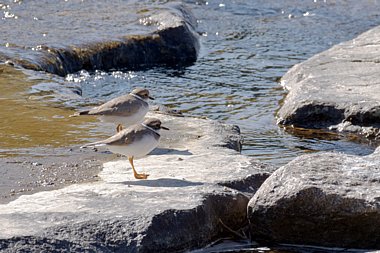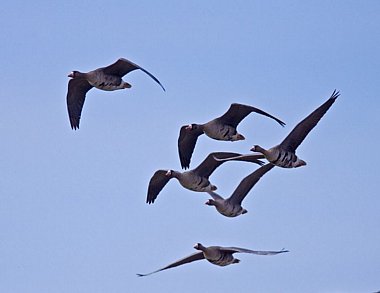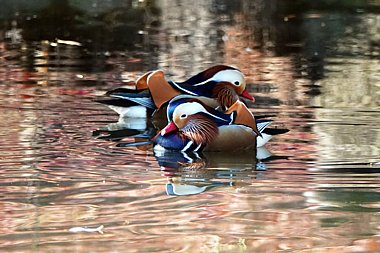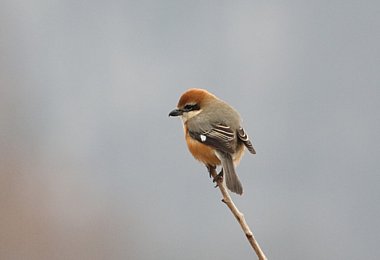South Korea
Exciting winter birding for Steller's Sea Eagle and Scaly-breasted Merganser at a recently-available Asian hotspot
| Destination | |
|---|---|
| Focus | |
| 2026 Dates | |
| Duration | 15 Days |
| Guides | |
| 2026 Price | Guide Price £6495 pp £695 single supplement. Deposit £1200 pre-flight airport hotel and lounge are inc. |
| Max Group Size | 12 |
- Free Bird Guide
FREE copy of Birds of East Asia with every room booked on this holiday.
- Enquire
Join Heatherlea on an exciting holiday to one of the recently discovered hotspots of Asian winter birding! This is a comprehensive birding tour of a modern country with high quality infrastructure, and relative ease of travelling between destinations, which enables us to cover the whole country and feature many hard-to-find East Asian specialities, and large numbers of other sought-after birds. Around 500 species have been recorded in South Korea, and we visit a range of major wildlife habitats; tidal flats, coastal lagoons, rice fields, rocky shorelines, headlands, rivers, open country, forests and scrubland including the DMZ, the land that time forgot between South and North Korea!
Our tour is timed in January to coincide with the presence of winter specialities, including the world’s largest concentration of Baikal Teal and highly-prized Scaly-sided Merganser. Flocks of Red-crowned Crane stand out on tidal-flats, while there may also be thousands of White-naped and Hooded Cranes too. We aim to see spectacular Steller's Sea Eagle, Swan and Lesser White-fronted Geese, Solitary Snipe, and Relict and Saunders’s Gull. Uncountable numbers of ducks and geese fill western coastal sites, possibly including rarities like Baer’s Pochard, while the formerly extirpated Crested Ibis has been reintroduced. As we travel around the country, we hope to see Varied Tit, Vinous-throated Parrotbill, Cinereous Vulture, Black-eared Kite, Eurasian Eagle Owl, Chinese Penduline Tit and Japanese Pygmy Woodpecker in suitable habitat. Pacific seabirds including Ancient Murrelet, Temminck’s Cormorant, Rhinoceros Auklet and Spectacled Guillemot on our boat trip will be a highlight. Asian Rosy Finch, Pallas’ Rosefinch and Siberian Accentor will be important finds in the mountains, and in the fields the range of Asian finches and buntings is outstanding.
En-suite hospitality is very friendly in clean and tidy Korean inns, and there will be plenty of opportunity to sample typical Korean food and drink – just watch out for the kimchi! There will also be time to explore the culture and history of Seoul at the end of the tour (with Oriental Turtle Dove, Azure-winged Magpie, wild Mandarin Duck and Daurian Redstart to distract even in city parks!). Due to the ever-expanding tourist industry in Korea, the country is likely to become a major birding destination in the not-too-distant future, so join Heatherlea at the start of this new wave, and discover the beauty of this hitherto little-known wildlife hotspot.
Enjoy your complimentary pre-flight overnight hotel before your holiday begins. Full details from our office! Read more about our Pre-flight Service here!
Days 1 & 2: London - Seoul
After relaxing in our complimentary VIP Airport Lounge, we fly overnight from London to Seoul, where we meet our local guide and transfer to our hotel in preparation for the birding ahead. Please note, most accommodations in South Korea do not have English-language websites, though we have provided links where they exist. All accommodation is en-suite, clean and comfortable. Overnight Seoul
Day 3: Han River and Namhansanseong
With any number of fantastic sites close to our accommodation, it is knowing where to start which will prove the biggest challenge! At the Han river, two of our prized targets, increasingly rare Scaly-breasted Merganser and quite spectacular Steller’s Sea Eagle may both may be found frequenting its upper sections. We hope for good views of these South Korean specialities, and also expect to see Whooper Swan, Falcated Duck, Chinese Spot-billed Duck, Smew, Goldeneye and Goosander.
We also visit Namhansan Mountain, exploring the forests for Hazel Grouse, Japanese Pygmy and (scarce) White-backed Woodpecker. Other woodland birds we may encounter for the first time include Varied, Marsh and Eastern Great Tit, Eurasian Nuthatch, Eurasian Treecreeper, Daurian Redstart, Yellow-throated Bunting and Hawfinch. Overnight Paju. Travel distance between cities c100 km per day.
Day 4: Han River downstream & Yeoncheon
Agricultural land around the estuary and at Yeoncheon can be very good for passerines and we may see our first cranes as we check the fields. Species in farmland and meadow habitat include Japanese Quail, Oriental Turtle Dove, Far Eastern Skylark, Bull-headed and Chinese Grey Shrike, Naumann’s and Dusky Thrush (with intergrades also likely), Japanese Wagtail, Vinous-throated Parrotbill, Oriental Greenfinch, Little, Rustic, Meadow, and Pallas’s Reed Bunting and perhaps Long-tailed Rosefinch. With plentiful prey, raptors are inevitably attracted to the area, with White-tailed Eagle, Rough-legged Buzzard, Goshawk, Peregrine and Merlin all possible. Two nights Cheorwon. Travel distance between cities c100 km per day.
Day 5: Tue 16 January Cheorwon DMZ
Perhaps the best crane-watching site in East Asia, we visit the demilitarised zone between North and South Korea for one of the highlights of this tour! With five different species possible, and with the help of a local guide we access the best viewing areas to watch large flocks of White-naped and Red-Crowned Crane feeding in the fields. Common, Hooded and Sandhill Crane are regularly recorded too (with a very slim chance of Siberian Crane), and the area supports one of the largest (several hundred) winter concentrations of Cinerous Vulture.
Wildfowl also feature here, large numbers of Whooper Swan, Taiga Bean, and Russian White-fronted Geese taking advantage of the abundance of winter stubble. Any unfrozen pools can provide feeding for Pintail, Gadwall, Tufted Duck, Pochard and occasional Baikal Teal and hunting raptors can include White-tailed Eagle, Eastern (Japanese) and Rough-legged Buzzard and we look for Eurasian Eagle Owl at dusk. With plans to spend the full day at Cheorwon, we can expect a good variety of eastern buntings and other passerines feeding in field margins and hedgerows too.
Day 6: Seoul National Arboretum
Just north of the city, situated in Gwangneung Forest, is the National Arboretum. Opened to the public in 1987, the 1,157ha site contains a diverse mix of trees and plants and is one of the healthiest forests in South Korea. On flowing streams, truly wild Mandarin Duck will be of interest to British birders though our main target will be a wader, the Arboretum having become one of the best places in the world to see Solitary Snipe! A few Green Sandpiper are often also present, and other desirable birds include Japanese Pygmy Woodpecker, Varied Tit and Chinese Grosbeak. Rare and interesting species can often be found here or at nearby parks and recent examples have included Yellow-bellied Tit, Black and Grey-capped Pygmy Woodpecker. After a bird-filled morning, we cross the country arriving on the east coast in late-afternoon. 2 nights Yangyang. Travel distance between cities c150km > c250km.
Days 7 & 8: Birding on the north-east coast
The bays, harbours, fields and lagoons on the east coast can be busy with birds, and there are many key species occurring which are not found on the west. Pacific seabirds can be difficult to see well, and a boat trip gives us every chance of success. Ocean going species including Harlequin Duck, Greater Scaup, Black and (Stejneger's) White-winged Scoter, Red-throated, Black-throated and Pacific Diver, Pelagic and Temminck’s Cormorant, Red-necked and Black-necked Grebe, Rhinoceros Auklet, Brunnich’s and Spectacled Guillemot, Long-billed and Ancient Murrelet may all be seen from our boat, or in bays and harbours as we explore the coast over two days.
Large concentrations of gulls regularly gather on this coastline, with Vega, Glaucous-winged, Glaucous, Black-tailed, Slaty-backed and Kittiwake featuring. The selection of wildfowl in the fields includes swans and geese, Blue Rock Thrush may be found at harbours or in urban areas and coastal scrub is often the winter home of a Siberian Accentor, Long-tailed Rosefinch or Tree Sparrow plus various Asian buntings. Overnight on day 8 at Taebaek (one night). Travel distance between cities approx 120 km per day.
Day 9: Taebaek Mountains
A change of scenery as we head into the Taebek range where Taebaeksan Mountain, at 1,567 meters above sea level is the highest peak. Historically considered the father mountain of South Korea, water originating from here forms both the Nakdonggang and Hangang rivers and enriches the plains below at Yeongnam. From mountain roads, we investigate good habitat for finches and buntings with Siberian Accentor, Pallas’s Rosefinch and Asian Rosy Finch top targets, the latter having established a regular, winter flock at Taebaek. After spending most of the day in the hills, we drive south to Upo in the afternoon. Overnight Changnyeong. Travel distance between cities c250 km.
Day 10: Upo Wetland
The largest natural wetland in South Korea and one of its most important floodplains, Upo is perhaps one of the best known birdwatching sites in the south. It is here, that Crested Ibis was re-introduced in 2019 having suffered extinction some 40 years ago (a species best known in Korea for a famous children's song, composed under the period of colonial Japanese rule which was consequently banned by the authorities for being considered subversive!). We hope to see the newly wild birds, and during our visit to the reserve look out for Great Egret, Eurasian Spoonbill, Oriental Stork (a few winter annually), Whooper and Bewick’s Swan, Lesser White-fronted, Tundra Bean and Swan Goose among several thousand Taiga Bean Geese, plus waders, gulls and passerines, perhaps including Chinese Penduline Tit and Buff-bellied Pipit. Overnight Suncheon Bay area (2 nights) . Travel distance between cities c120 km >160km.
Day 11: Suncheon Bay and Jiri Mountain
We drive south to Suncheon Bay, an important tidal eco-system supporting the largest wintering population of Hooded Cranes in South Korea. With more than 3,000 recorded in recent winters we spend time watching the cranes feeding in the rice fields.
Mount Jiri is the second tallest mountain (at 1,917m above sea level) in South Korea, and in the morning we explore the forested lower slopes within the Jirisan National Park. Established in 1967, this was the first National Park in South Korea, and the trails may give us White-backed Woodpecker, Brown Dipper, Japanese White-eye, Siberian Blue Robin, Red-flanked Bluetail, Pale Thrush, Olive-backed Pipit and more. There will also be a chance to go to a Buddhist temple that is over 1000 years old and look for a Hill Pigeon.
Day 12: Geum Estuary
One of the top five birding sites in South Korea, it is at Geum that we hope to witness one of the greatest spectacles in the avian world. Half a million Baikal Teal, more than half of the global population, overwinter in the area, and the late-afternoon flight of such a number of wildfowl will be a staggering encounter never forgotten! Around 5500 Far Eastern Oystercatcher Haematopus ostralegus osculans thought to be half the world population, and recently split as a distinct species, also winter here. The estuary also supports many other birds, notably waders and gulls. Far Eastern Curlew may be identified among Eurasian Curlew, and we should also see Long-billed, Kentish and Grey Plover, Eurasian Greenshank, Sanderling, Dunlin and Common Sandpiper. Relict and Saunders Gull are top targets at Geum, and we may also see Slaty-backed and Black-tailed Gull as we scan the flocks. Overnight Gunsan. Travel distance between cities c200 km.
Day 13: Seosan, Cheonsu Bay
On the west coast of Chungcheong province, Cheonsu Bay is one the most attractive birdwatching sites in South Korea. Large rice and paddy fields are filled with hundreds of thousands of geese and ducks, and the area is perhaps the most reliable for critically endangered Oriental Stork. Raptors can include Hen Harrier, Eastern Buzzard and Peregrine and we should also see Oriental Turtle Dove, Azure-winged Magpie, White-cheeked and Red-billed Starling, Brown-cheeked Bulbul, and Buff-bellied Pipit on this, our last full day birding.
We return to our comfortable hotel in Seoul for our final two nights.
Day 14: Seoul and Changgyeonggung Palace
We return north to Seoul in the morning to explore the city and enjoy a little final birding around the parks and gardens. We will plan to visit the impressive Changgyeonggung Palace in the heart of the capital, which was built in the 15th century by King Seongjong and has been the royal palace of the Joseon Dynasty for many years.
Day 15: Departure
We fly from Seoul to the UK, arriving in London the same day.
Please note: all itineraries are given as a guide only. Actual holiday content may vary according to the judgement of your guide, and elements beyond our control (eg weather).
What's included in your holiday price:
- return scheduled flight from London– Seoul, airport taxes, baggage and hand luggage up to airline included limit.
- airport transfers, ground transportation, accommodation and meals as specified.
- the services of a Heatherlea guide and local expert guides.
- east coast boat trip and all reserve entrance fees.
- The Heatherlea Pre-Flight Service offers everything you need at the airport, including hotels, car parking, airport lounges, regional flights, and upgrades. Let Heatherlea take the strain! Pre-flight airport hotel and lounge included free of charge subject to terms and conditions. Read more...
Free Field Guide! - ‘Birds of East Asia' by Mark Brazil, published by Helm 2008 is included in your holiday price. One copy pre room booked.

What's not included in your holiday price:
- travel insurance
- drinks & other personal expenses, laundry fees etc.
Your Leaders:
Byoungwoo Lee has almost 2 decades worth of experience developing and leading tours in South Korea. He has won awards for his work and we are delighted to welcome him to Heatherlea for this unique tour!
Byoungwoo Lee
Byoungwoo will be joined by one from the Heatherlea team on this tour.
More holiday information
Accommodation: We stay at comfortable hotels throughout and all rooms have private facilities.
Food: All meals are included (three meals per day). A good range of Korean food and drink will be available to sample. South Korean cuisine is largely based on rice, vegetables, seafood and meats with the famous kimchi served at almost every meal! Korean chicken, Bibimbap (rice, meat and pickled vegetables with a egg yolk), Japchae (glass noddles in a broth) and Korean Dumplings are all specialities of the region.
Walking: Easy for most of the tour, on good paths and trails over mostly level ground. On visits to the Taebaek and Jiri ranges, short walks will be slightly more undulating but nothing overly strenuous. A walking pole may prove useful.
Weather: Expect cold conditions, January temperatures ranging from -8C/23F to 5C/41F - so much like Scotland in winter! Bring warm, layered clothing including good jackets, hat, scarf, gloves and good walking boots..
Insects: There are unlikely to be any biting insects.
Visa: United Kingdom citizens will need a passport valid for at least six months from date of departure. A tourist visa is not required to enter South Korea, though please check at least 12 weeks prior to travel.
Flights: Scheduled return flights from London to Seoul.
Ground transportation is by comfortable mini-bus.
Optics: You should bring binoculars and a telescope may prove useful for scanning through large flocks of birds. Good photographic opportunities are also expected, though please note bird watching will take priority on this tour.
Other birding and wildlife holidays in South Korea
Why choose Heatherlea for your birding and wildlife holiday?
Our overseas holidays are planned with care to offer great birding and wildlife, led by capable Leaders who really look after you. Every holiday is run the 'Heatherlea Way', and we hope our Overseas Adventures remind you of the quality and care so many of you enjoy in Scotland. That means rewarding and exciting days in the field, and good quality accommodation and meals, with a real flavour of the country we are visiting. Heatherlea always seek to include the personal touches that make all the difference.
Heatherlea holidays are not ‘dawn to dusk’ expeditions. Our less-intensive approach is ideal for those who want to relax whilst experiencing the best wildlife watching, and wherever possible we organise early or late activity on an optional basis. We also take sensible breaks when in very hot places and regular comfort breaks on every holiday whenever possible. All itineraries are planned carefully around the best wildlife opportunities, and you won’t miss out on memorable wildlife, whilst enjoying relaxed, informal days that are great fun.
The really important part of any wildlife holiday is the experience for you, our valued customer. Heatherlea invest in many things to offer you the best possible service;
- We have been organising birding and wildlife holidays for over 30 seasons, and have a highly experienced and capable office team. We also offer a telephone and email service outside normal office hours.
- Heatherlea overseas holidays have a maximum of 12 clients per trip, putting the emphasis on personal service, and helping you get the best possible experience.
- Our holidays often include things which others might invite you to pay yourself, for instance Departure Taxes and tips to hotels.
- All elements of our holidays are sold under our own licence, ATOL 6113. Under ‘Flight-Plus’ legislation it is a legal requirement of any tour operator to hold an ATOL licence for the supply of any overseas holiday where a flight is involved, if that holiday includes either overseas accommodation and/or car hire. It can be a criminal offence for an operator to book flights as part of a package without an ATOL licence. Heatherlea also hold full Tour Operator Insurance for your added protection.
- Heatherlea is your complete wildlife holiday provider. Our ‘Back Office’ team can organise all your pre-flight and other travel needs. Our specialists will help you book the right services, at the best price. Book holiday extensions through us, and your ATOL protection is extended further. We don’t charge extra for this service.
- Heatherlea is a limited company, registered in Scotland, and registered to pay VAT (applies to all holidays within the European Union).
Trip Reports
- Free Bird Guide
FREE copy of Birds of East Asia with every room booked on this holiday.
- Enquire





























